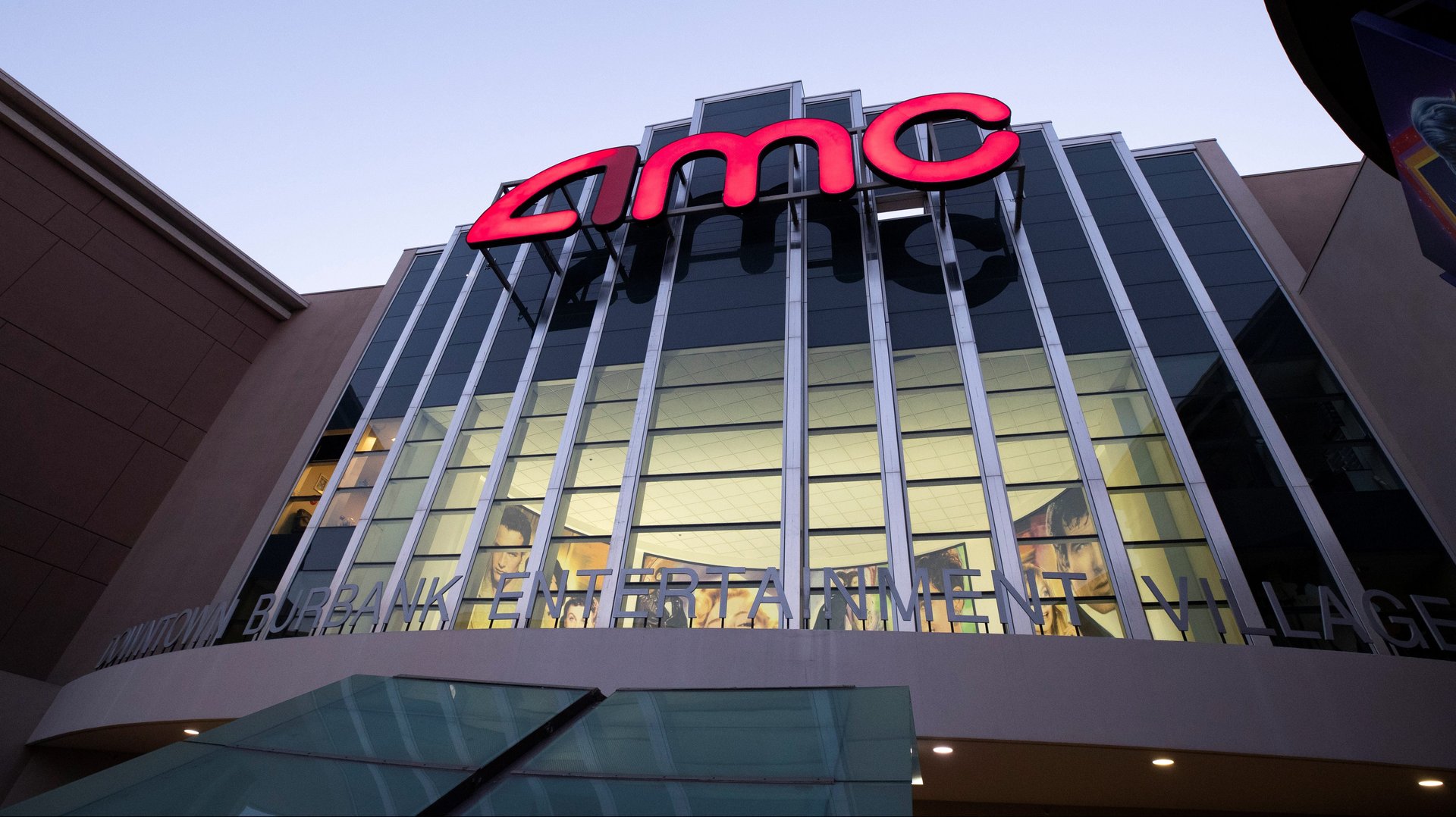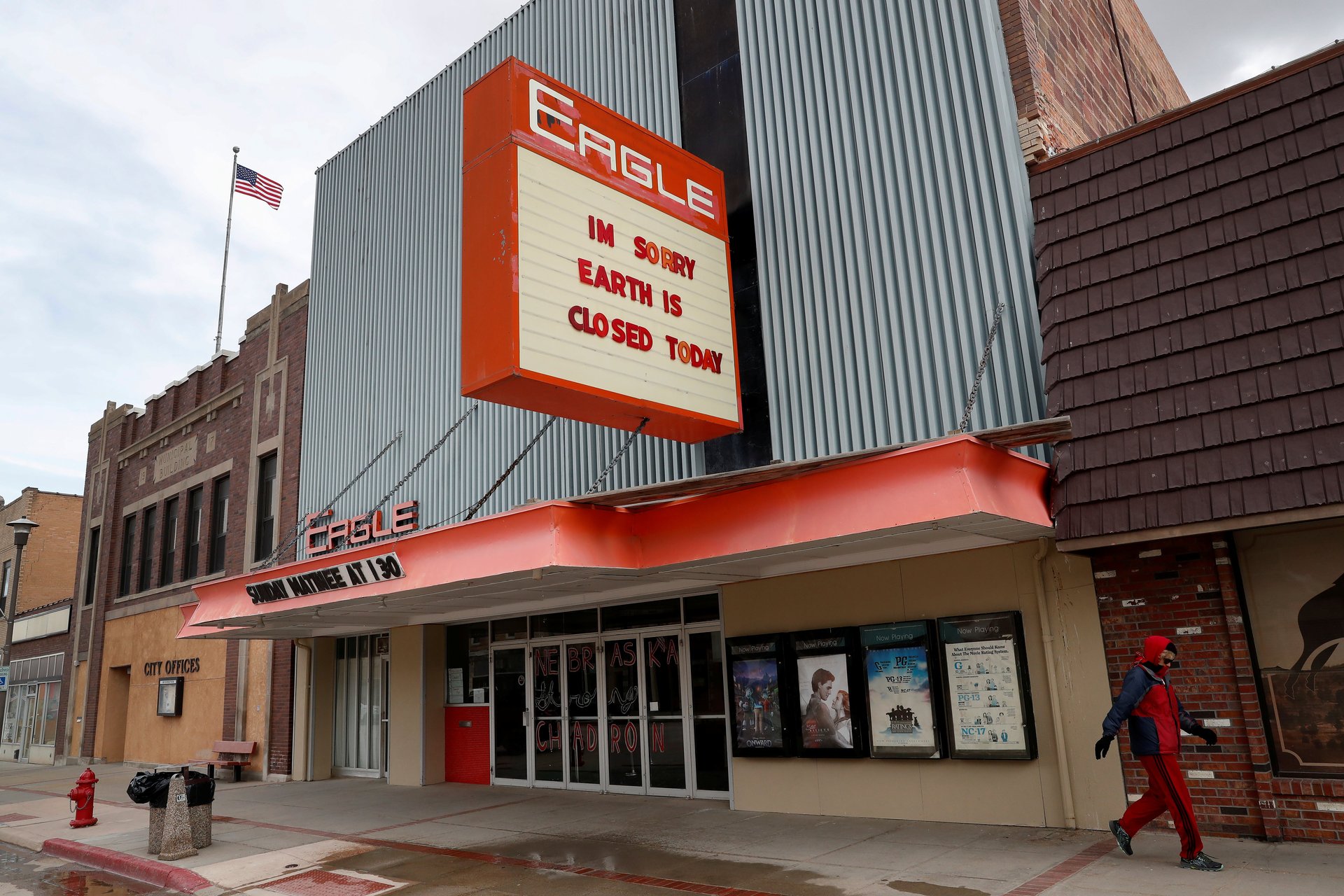How movie theaters can avoid extinction
On Christmas Day, the biggest Hollywood movie of the year will debut online. In the US, Wonder Woman 1984—the sequel to the 2017 superhero blockbuster Wonder Woman—will be available to subscribers of the HBO Max streaming service on the same day it premieres in theaters. So instead of watching it on the big screen, where virtually all films of its kind have been seen throughout history, most American audiences will just cozy up on their couches and hit play.


On Christmas Day, the biggest Hollywood movie of the year will debut online. In the US, Wonder Woman 1984—the sequel to the 2017 superhero blockbuster Wonder Woman—will be available to subscribers of the HBO Max streaming service on the same day it premieres in theaters. So instead of watching it on the big screen, where virtually all films of its kind have been seen throughout history, most American audiences will just cozy up on their couches and hit play.
The historic decision to make a potential $1 billion blockbuster movie available to watch at home, at no additional cost to streaming subscribers, was clearly influenced by the Covid-19 pandemic. WarnerMedia, the entertainment conglomerate owned by AT&T which operates the Warner Bros. film studio and the HBO Max service, decided it didn’t want to further postpone the release of the film, which had already been rescheduled several times from its original 2019 date. Instead, it saw an opportunity to boost its fledgling streaming platform.
But WarnerMedia didn’t stop there. This month, it announced that all of its 2021 films will follow the same path as Wonder Woman 1984: simultaneous releases in theaters and on HBO Max. For an industry that for a century was built on the primacy of movie theaters, the news was earth-shattering. WarnerMedia argued the move was made with fans in mind, offering them a choice of how they’d prefer to watch its movies.

In doing so, however, the company was tacitly admitting it didn’t care if a vaccine allowed for the safe return to theaters next year. It was going ahead with this plan regardless. Growing its streaming offering was more important to the future of its business than theaters.
The move, combined with similar strategic shifts toward streaming from studios like Disney, has ushered in another round of obituaries for the movie theater. Theaters have survived technological revolutions before: They fended off the advent of television, outlasted Betamax, the VCR, and DVDs, and combated improvements in home theater systems. (They even survived the 1918 Spanish flu pandemic.) But this time is different. Consumption habits have irreversibly shifted to hand-held devices and at-home experiences. And now the coronavirus has devastated what was an already struggling theater industry.
But such pronouncements are probably shortsighted. There will still be a place for the movie theater in five, 10, and 20 years into the future. What that place is—and what theaters will look like—is a matter of debate that won’t be settled quickly. What is clear is that theaters will change.

Table of contents
Setting the stage | Shiny new windows | Less demanding on-demand | The mass culling | The new owners | Physical experiences reimagined | The generational problem

Setting the stage
Some quick economics
To understand what the industry stands to lose if theaters shrivel up and die, we need to understand just how vital to the entertainment industry they are.
The average Hollywood movie makes a third of its lifetime revenue through theater ticket sales. The other two thirds flow from a combination of several “windows” (industry jargon for other types of distribution) that are predicated on the success or failure of a film’s theatrical release. Often, if a film performs well at the box office, it will do well with its other windows too.
So not only is a theatrical release a huge money-maker on its own, but it’s integral to the other forms of revenue generation. Those other forms include home video, pay-per-view, cable TV, broadcast TV, and streaming. Titanic made a ton of money in theaters in 1997 ($1.85 billion, to be exact), but it also landed its studio, Paramount Pictures, secondary and tertiary windfalls through home media sales and an HBO premiere in 1999, and then a broadcast TV debut a few years after that. The windows allow a studio to generate cash from a film decades after it leaves theaters.
The global box office is a $40 billion industry, with the US market representing almost a third of that ($11.4 billion in ticket sales in 2019). The movie studios and the theater operators generally split those profits evenly. It’s a partnership that’s been lucrative for both parties for a very long time.

Within the US, three theater companies combine to own nearly half of the market—AMC Theatres, Cineworld (which owns Regal Cinemas), and Cinemark. The other half is made up of smaller chains, boutique companies, and independent cinemas. AMC declined to make an executive available to interview for this story. Cineworld and Cinemark did not respond to requests for comment.
“There has never been a reason [for studios] to eliminate theatrical exhibition,” Michael Pachter, a research analyst at Wedbush Securities, said. “There are many thousands of pundits who are convinced that just because consumers prefer the convenience of watching at their homes, that every [studio] is just going to fall into that model and give it to them. It’s not going to happen.”
To make up for the revenue generated by theatrical releases, studios would have to grow the other two thirds of a film’s lifetime gross by 50% just to keep running in place. Streaming as an industry might be growing, but studios can’t rely on it solely to replace the financial impact of theaters—especially for big-budget “tentpole” films, which require hundreds of millions of dollars in ticket sales just to recoup the costs of their budgets.
“The theatrical window still remains a very important part of the marketing of films for studios,” Neil Begley, a senior analyst at Moody’s who covers the US film studios, said. “It creates buzz and word of mouth, social media reach, and it establishes the base for determining the values of all the windows that follow. They’d have to find another way to do that, and that is not terribly enticing.”
The current trajectory
Even before the pandemic, the US film industry was struggling to reverse a trend of slow, but steady decline. The question is if that can change, and if not, if it can even maintain status quo. That status quo is still lucrative, but it’s not one that’s likely to get more lucrative.
After hitting a peak of $14 billion in ticket sales in the early 2000s (adjusted for inflation), the US film market has hovered around $12 billion annually ever since. That’s including the rise of the superhero blockbuster franchise—which might be the only thing keeping the industry from slipping further.
In the US, theaters have been closed or operating at reduced capacity for months. The ones that are open have no new movies to show, since the Hollywood studios have either rescheduled all of their major releases until 2021 or put them directly on streaming services instead. The result is an industry at rock bottom.
“This pandemic accelerated everything theaters feared would happen eventually,” said Jeff Bock, the senior box office analyst for the entertainment research firm Exhibitor Relations.
That story isn’t the same everywhere. China’s film industry, for instance, has been growing every year. In 2019, it grossed $9.3 billion. Though below the $11.4 billion in the US, that marked an 8% improvement from China’s 2015 total. The US industry, meanwhile, has grown less than 1% from its 2015 total. The global film market has increased by about 2% over that time.
China is outpacing both the US and the world, and will overtake the US soon as the world’s biggest market for theatrical distribution. Already there are signs it will continue on the path it was on once the pandemic fully recedes.
“In China, which got a hold on the virus, the box office is now eclipsing pre-Covid levels,” said Eric Wold, a senior analyst at B. Riley. “It’s selling more tickets even with capacity restrictions—based on their own films, without Hollywood titles. It shows consumers do want to come back.”
How to capitalize on that potential excitement is a question every theater owner and Hollywood studio executive is asking.

Shiny new windows
The most significant innovation to the theatrical distribution model in decades is the shortening of the theatrical window—the amount of time a movie plays exclusively in theaters before it can be watched at home. Historically, that window was 75 to 90 days. It was meant to maximize theatrical profits and prevent other formats (namely home video) from cannibalizing that business. But at some point in the last decade or so, it became clear the math didn’t make sense.
Most Hollywood movies make the majority of their theatrical revenue within the first month of release. After that, they stop attracting audiences. Until now, movies weren’t allowed to be seen at home for another 60 days after they stopped making money in theaters. That’s two months of movies languishing, failing to make either the studios or the theaters any profits.
The new model allows films to generate revenue from home releases—like premium video on-demand—the moment they stop making money at cinemas. In exchange for allowing movies to leave their walls much earlier, the theaters are getting a cut of the studios’ digital revenue. (Nobody will say how much.)
“It’s a really practical and effective step forward,” said J. Christopher Hamilton, an assistant professor of television, radio, and film at Syracuse University, and a former executive at Disney and WarnerMedia. “It will usher in even more variations.”

So far, only Universal Pictures has struck these deals with exhibitors, agreeing with AMC and Cinemark to play all of its films in those theaters for a minimum of 17 days (over three weekends). After that, Universal has the option to make those films available to consumers for digital rental in addition to, or instead of, showing them in theaters. The films that are crushing it at the box office will likely remain in theaters exclusively. Everything else could end up on streaming or on-demand services after brief stays in theaters.
“If you’ve got a title that, after a couple of weeks, is just playing horribly and no one’s going to see it, the theaters don’t want to have to keep dedicating screens to empty auditoriums, and the studios want to pull it out of there so they can push it to another channel,” Wold said. “It’s to protect both sides from a crummy film.”
The shortened windows will also lead to theaters becoming even more dominated by blockbusters than they already are. Mid- and low-budget movies will have short shelf lives in theaters, if they even go there at all. Want to see a big superhero movie like the Avengers? For that, you’ll probably still have to leave the house. But for most other movies? You may not have to get off the couch.
On an earnings call last month, AMC CEO Adam Aron said the company was “not stuck back in 1955” and was willing to consider new business models in order to survive the next era of entertainment. “We understand that the world of streaming is upon us,” Aron said.

Less demanding on-demand
Negotiating a new profit-sharing scheme through which the theaters get some of the studios’ premium video on-demand revenue is exactly the kind of innovation theaters should be thinking about. But they’ll have to do more.
Premium video on-demand, or PVOD, is when consumers rent a movie at home from a digital rental service like Amazon or iTunes, usually for $20. (Disney made Mulan available as a PVOD offering on its streaming service for $30, plus the cost of a monthly subscription.) The studios keep about 80% of that revenue, the rental services get the other 20%. The issue is the premium cost has priced a lot of consumers out of the format altogether. Nearly all of the analysts Quartz spoke to believe the industry should have tried sliding scale PVOD prices a long time ago.

“Why not try to ‘window’ the windows?” Pachter said, referring to a model in which PVOD prices decrease the longer a movie is available. “If I can come up with this, how is it that the studios haven’t figured this out yet? It blows me away. Studios have been ridiculously stupid in how they’ve approached PVOD.”
Whether or not that changes, the fact that studios are coming around to the idea of sharing profits with their theatrical partners is a good sign they still believe cinemas can thrive.
“Theatrical might be a wounded creature right now, but it will come back and be a coveted partner,” Comscore senior media analyst Paul Dergarabedian said. “These are businesses you’ll still want to be in. By sharing in PVOD, it’s creating a shared future between the two entities.”
Another idea Dergarabedian floated is to bundle together theater tickets and digital rentals, giving consumers the choice to watch films however they want for one price. Perhaps, in the future, if you pay to see a Marvel movie in theaters, that will also grant you access to stream it at home later. That concept might have seemed crazy to theater operators just a few years ago, but what constitutes a radical idea has shifted dramatically since then.

The mass culling

Soon, we’re likely to see an elimination of theater locations and screens. Many theater companies are deep in debt. Leaving out the possibility of innovation, just to stay functioning at all, theaters will have to cut bait on the locations that weren’t performing pre-pandemic and get rid of excess screens at multiplexes.
Of the roughly 45,000 screens in the US (spread out across 5,500 sites), about 17,000 are owned by the top three exhibitors (AMC, Regal, and Cinemark). Most observers expect the majority of those screens to survive. But of the other 28,000 screens, analysts say as much as a third of them may not make it. Pachter expects there to be only about 30,000 screens in the US in the next five to seven years.
For consumers, that means far fewer theaters to choose from in most places. But if you’re lucky enough to live in a major city like New York or Los Angeles, you may not notice a major difference. The AMCs, Regals, and Cinemarks will service an even greater swath of the market than they already do, while smaller operators fight over the scraps.
Sadly, this also means independent cinemas—many of which have already closed due to the pandemic—will struggle to stay alive even if economic conditions improve. In countries like India, where there are large, homegrown independent cinema industries, many smaller players could be squeezed out by multiplexes and streaming. Like most small businesses, they’re on their own.
“This pandemic is probably going to slam the door shut on what’s left of the ‘main street’ older, smaller theaters,” Begley said.

The new owners
AMC is running out of money. The company says it has enough capital to get through the first few months of 2021, but it needs to raise more. Other exhibitors like Cineworld and Cinemark also need cash, though they aren’t in quite as dire straits.
In most cases, a business that runs out of money ceases to be a business. But there’s a sense in the industry that despite their immense struggles, movie theater chains are too big to fail. Studios need them. And, crucially, real estate companies need them. Theaters are often anchor tenants for shopping malls. The physical spaces were designed specifically to be movie theaters. It’s hard (and expensive) to turn them into anything else.
So the theater operators have some leverage, but not much. They need external help.
Perhaps the most likely option is that private equity sees an opportunity in the pent-up demand for out-of-home experiences after the pandemic and steps in, throwing some cash at theater operators to keep them afloat. The firm Silver Lake invested $600 million in AMC in 2018 (and now owns a minority stake in the company), and already has another deal in place to reduce the theater chain’s debt through the first half of 2021.
But those are short-term fixes. To really inject new life into the industry, theaters need a lot more money—and an actual vision. For better or worse, only a few companies can offer both.
Does Big Tech get involved?
Amazon could be one. AMC’s stock surged in May on the mere idea that Amazon was interested in buying it. The rumors never amounted to anything (yet), but they were rooted in an idea that some insiders believe is inevitable: that Big Tech attempts a takeover of the distribution of film, seeing as they’ve spent heavily on the production of it. One of them investing in or outright owning a chain of theaters is a possibility.
“There is so much money on the table,” said Shawn Robbins, the chief analyst at Boxoffice Pro. “For anybody who is running a theater where it’s still financially feasible, someone is going to step up and help save them.”

That may not necessarily be a tech company, but they make sense, given their deep pockets and interest in tracking consumer behavior. Of course, antitrust concerns could make such a proposition a nonstarter. Plus, any tech-owned theater would likely have to serve several purposes to make the potential logistical headache worth it.
“There would have to be an ulterior motive,” Begley said. For Amazon, that might be tying theaters into its existing Prime subscription service, or to collect new data to then sell to advertisers. In an increasingly subscription-based economy, companies that are already subscription titans could succeed with theatrical subscriptions where upstarts like MoviePass failed.
MoviePass, which offered moviegoers unlimited movie tickets for a $10 monthly subscription, had a completely unsustainable business model. But a tech company with virtually endless resources could sustain a few losses. They wouldn’t even have to own the whole theater companies to benefit.
“I don’t see one of those companies acquiring a theatrical house, but I do see one of them partnering or investing in an experiential endeavor that would serve both businesses,” Hamilton said.
The act of committing to the future of the theatrical experience might also garner a lot of goodwill in Hollywood, helping to make Amazon—or whichever tech giant decides to take the plunge—a favorite of industry royalty, if it’s seen as the savior of theaters.
The studios themselves could jump in
Another option, which is about to be legal for the first time in decades, is that the movie studios cut out the middlemen and take over the theaters themselves. In a 1948 landmark antitrust case known as the Paramount Decrees, the US Supreme Court barred Hollywood studios from owning theaters, and thus monopolizing both the production and also the distribution of films.
But earlier this year, the US justice department terminated those decrees, arguing the competitive landscape has evolved since then. “Consumers today are no longer limited to watching motion pictures in theaters,” it said in a statement. “New technology has created many different distribution and viewing platforms that did not exist when the decrees were entered into.”
With the decrees terminated, theaters could eventually be owned by studios like Disney or WarnerMedia, granting them the chance to control every aspect of the theatrical experience—without splitting the profits with another party. “The possibilities, given the amount of resources, are endless,” Robbins said. “You’d have the content creators given an ability to set up an experience specifically for their customers.”

There’d likely be further regulatory scrutiny. And it’s unclear if a company like Disney would even be interested. Though it might be a potentially lucrative enhancement to its already massive entertainment empire, it would come with its own hassles. Disney has plenty of challenges on its plate already. But if any studio tries it, it’d probably be Disney.
“Out of all of them, Disney makes the most sense because they’re such a family brand,” Hamilton said. “They could do a lot with innovating and creating an interactive experience using their properties.” Imagine leaving a theater after seeing the next Star Wars film and walking directly into a Disney store, where you can buy merchandise from the franchise.
Still, Hamilton and others think it’s more likely the decrees open up the possibility that studios merely invest in theaters without owning them outright. Universal has already shown a commitment to theaters by cutting them in on some of their digital rental revenue. It could go one step further.
“If Universal wants to help their largest distribution partner out, they can give them a little bit of a lifeline to get them to the summer,” Wold said.

Physical experiences reimagined
Observers say the pandemic—and the subsequent pause in moviegoing—presents an ideal opportunity to rethink what theaters can or should be.
The core proposition of a movie theater is that it surpasses the home viewing experience. But with home theater systems improving, there’s a sense the trip to the theater has failed to fully differentiate itself from watching a movie from the couch. Over the next five years, analysts expect theater owners (whoever they may be) to experiment with the out-of-home viewing experience—far beyond popcorn, soda, and comfy seats.
The theater of the future may be a quasi-theme park: indoors, with interactive media experiences instead of rides. You’re not only there to see a movie, but also to engage in other live, in-person events that can’t be recreated at home.
“Facebook with an Oculus Rift tie-in could be an option,” Begley said. If the industry shifts to more immersive experiences, that would require facilities with the right engineering and technology. “It’s too early to suggest that’s going to be the new theater experience,” he said, “but I’d be very surprised if we didn’t see it at least attempted.”
Theaters in the future may have to offer some assortment of additional experiences, even if no one really knows what those will be yet.
“Amazon could use AMC’s theater network to not only show their own films—opening up another avenue of fans that didn’t have access to their films on Amazon Prime—but also to use brick-and-mortar theaters to boost their other businesses,” said Gregory Fraser, a senior analyst at Moody’s who covers the major US theater chains. “They could do live gaming events with Twitch and make that a new experience for the moviegoer.”


The generational problem
Suppose major theater chains do manage to return to some semblance of pre-pandemic normalcy. But that normalcy was one younger audiences weren’t thrilled with. According to a report by the Motion Picture Association, though every US age group dropped in per capita attendance from 2018 to 2019, 18- to 24-year-olds suffered the biggest drop. The age 25 to 39 age group, which roughly covers Millennials, saw a decrease in per capita theater attendance each of the last three years. The groups that have historically been the movie theater’s most loyal customers may be slowly losing interest amid the sea of competing media and entertainment.
If older moviegoers are hesitant to return to theaters after the pandemic, the industry will need younger ones even more to reverse this trend. There are little signs that will happen, given the plethora of instant entertainment options they’re already using, from TikTok to Twitch.
“Gen X and Boomers love the theatrical experience, but the next generations aren’t so enamored with it,” Bock said. “They don’t want to be hampered by showtimes. They will be good consumers to these companies, but on their own terms.”
Unlike older generations, younger ones don’t necessarily have a theatrical bias toward certain franchises. James Bond, for instance, is a must-see theater event for older crowds who grew up watching Bond movies at the cinema. Gen Z, and the generation after it, might not even know who James Bond is. They certainly won’t care about how they see those movies, if they see them at all.
That poses an enormous challenge for the old Hollywood guard, which is not set up to address the evolving concerns of younger consumers.
“The media companies are run by the same old white guys that run most industries,” Hamilton said. “They’re fearful of change, they’re scared of innovation. They don’t want to alienate Wall Street. Everything they do, they do with extreme caution, which is why they’re late to all these changes. In their current structure, they’re not equipped to service the generation after Gen Z.”
The good news for cinephiles is that few actually believe the theatrical experience will simply die. There is something special about the movies, something that has kept it shielded from catastrophe before—and could do so again.
“Ultimately, we’re analog beings,” Dergarabedian said.
The communal, tactile experience of sitting in a darkened movie theater with strangers, collectively experiencing emotions, is the foundation on which film was built. There will always be some demand for those moments.
“The big screen is the raison d’etre for this industry,” Begley said. “There is a place for it, and that will be lasting.”